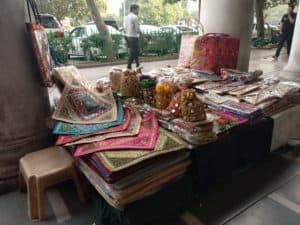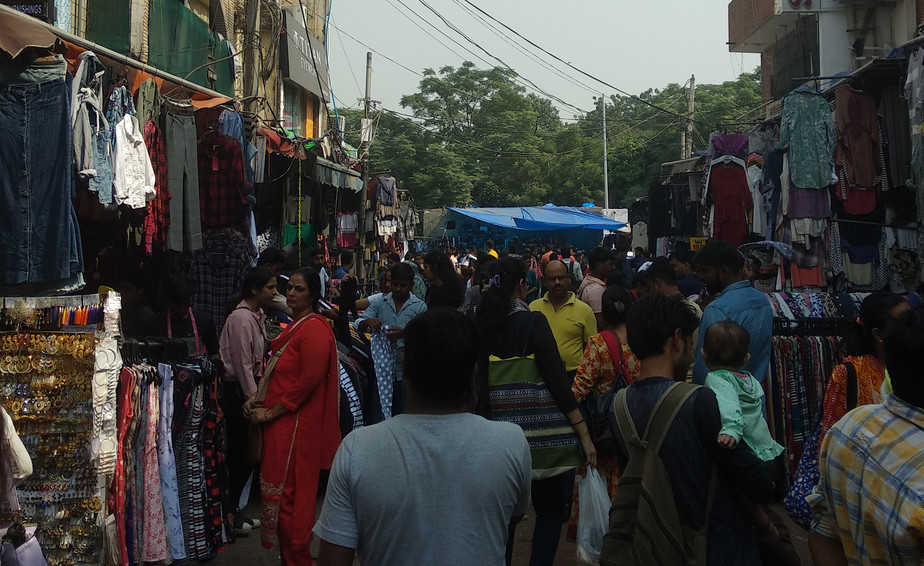From being evicted to getting their materials confiscated, street vendors in the capital continue to face uncertainty even four years after the implementation of the Street Vendors Act
“I sat on a hunger strike at Jantar Mantar in 2014, in order to get the Street Vendors Act passed, so that I could have a stable income and my children could go to school,” says Kanchan Devi, 40, a street-vendor at Sarojini Nagar market.
Along with her husband, Devi sells socks and woollens. She earns about Rs 500-1,000 in a day, if the NDMC (New Delhi Municipal Corporation) doesn’t make an appearance. If they do, then Kanchan has to pack everything in five minutes and run to a safe place — out of sight of the officials — and wait for them to leave, so that she can get back to business.
“It’s chaotic when they come here. Stall owners run like the place has been hit by an earthquake. Sometimes the customers also get paranoid and run to a safe place,” says Devi. She adds that memories of the 2005 bombings in the area still haunt some shopkeepers and regular customers.
For Devi this is an everyday routine that has been going for the last 20 years since she’s been in the market. In 2011, she moved the Delhi High Court after she was asked to remove her stall by the NDMC. After the HC’s intervention, she was able to return to the market after three months.
As these eviction drives continued, Devi got frustrated and sat on a hunger strike at Jantar Mantar, along with 16 other street vendors. She hoped for a better future when the Parliament passed the Street Vendors Act in 2014. Little did she know that the future still held the same uncertainty for her as before.
Devi, like many other street vendors in the city, is part of a survey being conducted by the NDMC. There is nothing reassuring about this latest development, for they are still in a state of uncertainty about whether their stall in the market will come under the vending or the no vending zone.
As of now, only two of 26 town vending committees (TVCs) have conducted surveys in their respective areas — Sarojini Nagar and Connaught Place.
When Patriot spoke to other street vendors in Sarojini Nagar market to see what the survey entails, the shopkeepers, even though they did not have much idea about what was going on, seemed certain that they would not get to see any positive action in the future.

Bharat Ratan, 60, another street vendor who has been selling kids’ clothing in the market since 1992, is waiting to go to the wholesale dealer to get more material for his shop. Since a notice was sent to the street vendors association group, which stated, “Please remain at your stall for the three days of the survey,” Ratan will have to wait till the survey gets over.
Speaking about the survey, Ratan says, “They (NDMC) only checked a few stalls, asked for the challan and a copy of the court’s order, clicked some photos and left.” The survey also gives street vendors three days to submit documents, like copies of the challan, to the NDMC officials. According to Ratan, one and a half days have already been spent in conducting the survey at the nearby Babu Market, while he and other stall owners of Sarojini Nagar market have been waiting.
He further explains that since 2011, NDMC officials have been postponing the survey process and have been asking the court for new dates. Even after the Act was passed, the situation hasn’t changed much for him as earlier too, he used to run from one corner to another with his belongings and he still has to do so.
Ukham Bai, who has been running a stall in the market since 1998, is a little satisfied with the situation after the Street Vendors Act was passed. She says, “I have the receipt and the order from the court. The police or the NDMC officials don’t do anything to me.” However, she says that there have been instances when street vendors have been asked to remove their stalls, even after having all the required documents.

According to these stall owners, the ones who have stalls in the middle of the lane in the market are most vulnerable to being evicted by NDMC.
Ashutosh Gupta, 55, who has been selling candy and mouth fresheners for the last 25 years, says that he’s still vulnerable to being evicted, even after having all the required documents. He operates his stall in the middle of the lane. “When I show them my documents they say that it’s of no use and ask me to vacate the place,” says Gupta.
Once when the officials got hold of his belongings, he had to pay Rs 1,000 as fine. “The fine that has to be levied is not Rs 1,000 officially, but they don’t give back our belongings if we refuse to pay that much,” adds Gupta.
Section 3.3 of the Street Vendors (Protection of Livelihood and Regulation of Street Vending) Act, 2014, states that no street vendor shall be evicted or relocated till a survey has been completed and the certificate of vending is issued to all vendors. But the eviction drives in order to blame the vendors of encroachment in the markets have not stopped.
In Connaught Place, the situation varies from stall to stall. Uma Devi, 62, has been selling handlooms since 1987 and proudly says she got the license in 1994, which lets her operate the stall in the middle of two of the many pillars in Connaught Place, without any harassment. “The police and the officials have been seeing my face since years. They know that I have all the required documents and sometimes they don’t even ask me anything,” she says.
Since the survey is ongoing in Connaught Place, she has been told that she will be shifted to a new place, which will have a shed too. “I’m excited about that,” she adds.
According to Irfan Khan, the Delhi-NCR coordinator of National Association of Street Vendors India (NASVI), the TVC which is supposed to identify the vending and no vending zones, has been formulated for six months, while the Street Vendors Act, 2014 states that it has to be formulated for a maximum period of five years.
Khan also alleges that there are some officers who have been taking bribes to let some stall owners in Lajpat Nagar run their business smoothly. “We will soon go to the Deputy Commissioner and present the matter to him,” he adds. He also says that the NDMC and the police have their own rules and style of working but some of the major street vendors also try to disrupt the stall owners who fall at the bottom of the hierarchy.
“They will run their own dalal system and have been trying to spread a rumour that in order to get the survey done, one needs to pay Rs 20,000, which is wrong,” says Khan.
Rajkumar, another vendor in the area, has no idea about the survey or the documents required to run his business. As he sits waiting eagerly for his customers in the scorching heat, he is also on the look-out for the officials. “There are no timings as such. They can come at any time of the day,” says Rajkumar.
In 2015, a study done by the Centre for Civic Society, says, “Street vending has not been included in urban planning, which seems to be a huge drawback for the street vending activity. Though National Policies envisaged the inclusion of street vending in the master plan; the same is yet to be incorporated by the authorities responsible.”





